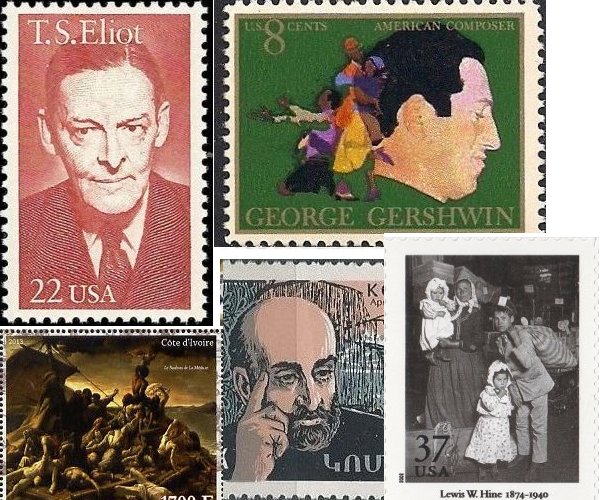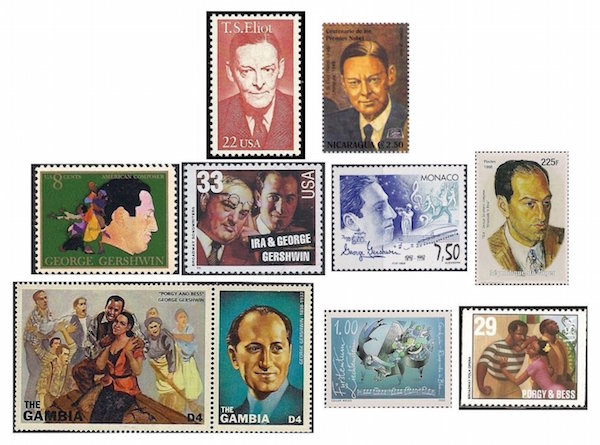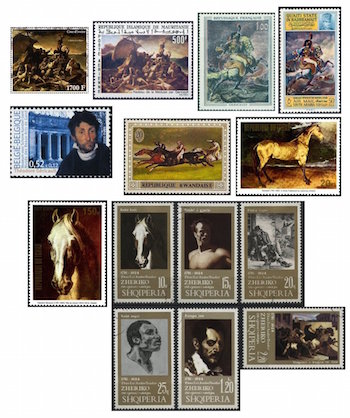The Arts on Stamps of the World — September 26
An Arts Fuse regular feature: the arts on stamps of the world.

By Doug Briscoe
Today’s Big Three would be T. S. Eliot, George Gershwin, and Théodore Géricault. We also greet an American cartoonist, the Armenian composer Komitas, American photographer Lewis Hine, a Yugoslavian sculptor, an Australian painter, actors from Serbia and India, a French stamp designer, and Olivia Newton-John. We also recognize two other anniversaries, one for an opera and one for an opera house.
The poetry of T(homas) S(tearns) Eliot (26 September 1888 – 4 January 1965) has been set by many prominent composers. Britten used Eliot’s words in two of his Canticles (“The Death of St. Narcissus” and “Journey of the Magi”), and the final section of Arthur Bliss’s choral work Shield of Faith (1975) comes from the Four Quartets. Humphrey Searle set two of the pieces from Old Possum’s Book of Practical Cats in 1956. That same source had been used by Alan Rawsthorne in a 1954 work for speaker and orchestra. Other examples are Stravinsky’s Anthem (“The dove descending breaks the air,” 1962), the Five Eliot Landscapes, Op. 1 (1990), by Thomas Adès, and Sofia Gubaidulina’s Hommage à T.S. Eliot for soprano and octet (1987), plus settings by David Diamond, the late Einojuhani Rautavaara, et alia. In the non-vocal arena, “The Hollow Men” inspired the orchestral work (1944) of the same name by Vincent Persichetti.
I show some of the many worldwide stamps honoring George Gershwin (September 26, 1898 – July 11, 1937). I daresay you’ve heard of him.

The most famous painting by Théodore Géricault (26 September 1791 – 26 January 1824) is probably The Raft of the Medusa, so we begin our perusal with two stamps reproducing that masterpiece of 1819, one from the Ivory Coast and one from Mauritania. The next most famous is perhaps The Charging Chasseur (1812), which was Géricault’s first major work, shown at the Paris Salon, and which we see on stamps of France and the Qu’aiti State. The next row begins, not with what you might expect at a glance to be a self-portrait, but rather Portrait of a Kleptomaniac (1822), one of a series of ten paintings of persons afflicted with mental aberrations made at the request of the psychiatrist Étienne-Jean Georget. In the same row we have two of a number of paintings of horses, The Derby of Epsom (1821) and Horse in the Storm (1820-21). Yet another, Horse Head (1815), is shown on two stamps, the first from Chad and the second from a full set of six Géricaults from Albania. The other five paintings and drawings are: Study of a Head (1812), Sorrows of a Poor Old Man (1821), Head of a Black Man (c1818-19), the much-anticipated Self-Portrait, and The Wild Horse Race at Rome (1817). Incidentally, another wonderfully expressive African face is captured with quiet dignity in Study of a Model (also from c1818-19). Yet another victim of tuberculosis, Géricault died in Paris at 32.
Winsor McCay (c.?1867–71 or September 26, 1869 – July 26, 1934) was an American cartoonist, illustrator, and pioneer animator who created a dozen comic strips beginning in 1903. The most celebrated of these was Little Nemo (1905-14; 1924-26; see the stamp). This strip McCay developed into the first (from 1911) of his series of animated films, including also Gertie the Dinosaur (1914) and The Sinking of the Lusitania (1918), which required 25,000 drawings and two years of work. McCay took meticulous care with his detailed drawings and invented techniques or expanded the possibilities in both the static and animated arenas. McCay’s primary employer was William Randolph Hearst, who insisted that the artist curtail his “extracurricular” activities to focus on editorial illustrations for the Hearst papers, a source of frustration for McCay. He regarded himself as an artist. I think he was right.

It’s a curious coincidence that two of the most revered Armenian composers are represented here within a few days of each other. We marked the anniversary of the death of Sayat Nova on Friday, and today is the birthday of composer, musicologist, and choirmaster Soghomon Soghomonian, better known as Komitas (1869–1935). He was born in western Turkey. His mother died when he was 6 months old and his father when he was aged 11. Although adopted by an uncle, he was neglected until taken by the local Armenian bishop to Etchmiadzin, where the Gevorgian [sic] Seminary was looking for an orphan boy with a good singing voice. He was ordained in 1894 and given the name of a 7th-century poet and musician, Catholicos Komitas. In that same year he completed a collection of folksong transcriptions that was frowned upon by the ultraconservative ecclesiastical faction. In the following year, he left Etchmiadzin to study harmony in Tiflis, and in 1896, thanks to the generosity of a wealthy Armenian oil man, was able to travel to Berlin for further study. He returned to the seminary in 1899, but moved to Constantinople in 1910. There he formed a choir to perform Armenian folk music. Eventually he collected and transcribed over 3,000 pieces, though more than half of these were subsequently lost. 102 years ago this past April, he was arrested by the Ottoman government and taken to a prison camp as one of the countless victims of the Armenian Genocide. Although he did not lose his life, he suffered an extreme case of what today we would call PTSD and had to be moved to a Turkish military-operated hospital, thence to psychiatric hospitals in Paris, where he lived the rest of his days. For this reason he is considered to be a martyr of the genocide. Admired by Debussy and others, he is deemed the founder of the Armenian national school of music and a pioneer of ethnomusicology.
Lewis Hine (September 26, 1874 – November 3, 1940) used his mastery of photography for social change. This is not surprising in view of his having studied and then taught sociology. It was through using photographs as a teaching tool that he saw their potential for social reform. To cite a salient example, his photos were a significant element in changing child labor laws in the United States. Hine often risked considerable personal danger to acquire these pictures. He photographed Red Cross workers during and after World War I. He documented the construction of the Empire State Building. He worked for the TVA and the WPA. Hines’s work has twice featured on stamps on the United States, first as one of twenty “Masters of American Photography” on a 2002 sheet, and again with a 2013 issue called “Building a Nation”, for which ten of the twelve images chosen were taken by Hines. The earlier issue gives us “Looking for lost baggage, Ellis Island, 1905”, and to represent the later one I selected “Power house mechanic working on steam pump” (1920).
The Yugoslavian sculptor France Gorše (26 September 1897 – 2. August 1986) lived a long life. He fought in the Austrian army on the Italian front in World War I and died seven decades later. In those many years he traveled much, lived and taught in Trieste and various Yugoslavian cities, and spent nearly twenty years (1952-71) in the United States. Portrait busts of celebrated Yugoslavians constitute a substantial portion of his work, but the pair of Slovenian stamps shows us his pieces Peasant Woman and Bashful Armor. A similar piece to the latter is his Deklica (1940), which I find enchanting.

From photography and sculpture we turn to painting and once again go halfway around the world, although our next subject, Australian modernist Lina Bryans (26 September 1909 – 30 September 2000), was born actually in Hamburg. Her wealthy parents happened to be visiting Europe at the time. Indeed Lina’s childhood was spent between Australia, England, and France. It was only after her first marriage, childbirth, and divorce that Bryans became interested in painting. Eventually she bought a house in a northern suburb of Melbourne that became a center for artists and writers. Her own first show was held in 1948. She painted 73 portraits of her friends, of whom many were prominent persons involved in the arts in Australia. The stamp from a set devoted to modernist women painters gives us The Babe Is Wise (1940).
And now we come to our three stars from the entertainment industry, Milosav “Mija” Aleksić, Dharamdev “Dev” Anand, and Olivia Newton-John.
Serbian actor Mija Aleksić (26 September 1923 – 12 March 1995) was extremely lucky to survive the 1941 Kragujevac massacre, in which nearly 3,000 men and boys were slaughtered at the hands of the Nazis in retaliation for partisan attacks. After the war he entered the theater, playing both dramatic and comic roles, though he came to be better known for the latter. His greatest success was on Yugolav television in sitcoms, one called the Mija Show, and educational children’s programming.
Indian actor Dev Anand (26 September 1923 – 3 December 2011) was also a comedian, but diversified as a writer, director, and producer. His breakthrough film as an actor was a 1948 picture called Ziddi; the next year Anand opened his own production company. He formed a reciprocal arrangement with Guru Dutt by which, if one of them became famous, Dutt would direct Anand’s productions, and Anand would act under Dutt’s direction. Anand’s own directorial debut was with Prem Pujari in 1970. Ultimately he directed 19 films and produced 35.

English-born singer Olivia Newton-John (born 26 September 1948) is the granddaughter of the Nobel Prize-winning physicist Max Born. She and her two siblings were taken by their parents to Melbourne when Olivia was six. While still a child she was appearing on Australian TV, she recorded her first single in 1966 and released her first solo album in 1971. She appeared with John Travolta in the hit musical Grease (the film version, that is) in 1978, and has sold something like 900 million records. She went into remission from breast cancer in 1992, but the disease has returned just this year. Ms Newton-John remains optimistic.
Pierre Albuisson (born 26 September 1952) is a copious engraver of French and Monegasque postage stamps and has also designed a fair number of them. He was born in Madagascar and is entirely self-taught as an engraver. His first design was for a Pierre Curie stamp for the French colony of Mali in 1981. We see that one along with two more he designed for Monaco, one for the 50th anniversary of Watson and Crick’s DNA model and the other for Princess Grace.
Donizetti’s Lucia di Lammermoor had its first performance on 26 September 1835 at the Teatro San Carlo in Naples. The opera is specifically cited on a Donizetti stamp from San Marino.
On this date in 1748, the Margravial Opera House opened in Bayreuth (the only connection with the Wagner Festival is that Wagner was initially attracted to the location because of the house). The building was constructed on the orders of the Hohenzollern Margrave Frederick of Brandenburg-Bayreuth (1711–1763) and his wife Princess Wilhelmine of Prussia (1709–1758), sister of Frederick the Great and herself a musician and composer. The structure was not quite complete yet, but served for the performances of two operas by Johann Adolf Hasse. After the deaths of the princess and the margrave the building fell into disuse, and that fact has been credited with the structure’s longevity, since such buildings often fell victim to fires started by the abundance of candles used; and the house was fortunately spared during World War II, so it has come down us from the 18th century virtually intact. It was added to the UNESCO World Heritage List five years ago (30 June 2012).
Three very great classical performers share this birthday along with the remediable ignominy of stamplessness: Franco-Swiss pianist Alfred Cortot (26 September 1877 – 15 June 1962), Alsacian conductor Charles Munch (26 September 1891 – 6 November 1968), and German tenor Fritz Wunderlich (September 26, 1930 – September 17, 1966).
A graduate of the University of Massachusetts with a B.A. in English, Doug Briscoe worked in Boston classical music radio, at WCRB, WGBH, and WBUR, for about 25 years, beginning in 1977. He has the curious distinction of having succeeded Robert J. Lurtsema twice, first as host of WGBH’s weekday morning classical music program in 1993, then as host of the weekend program when Robert J.’s health failed in 2000. Doug also wrote liner notes for several of the late Gunther Schuller’s GM Recordings releases as well as program notes for the Boston Classical Orchestra. For the past few years he’s been posting a Facebook “blog” of classical music on stamps of the world, which has now been expanded to encompass all the arts for The Arts Fuse.
